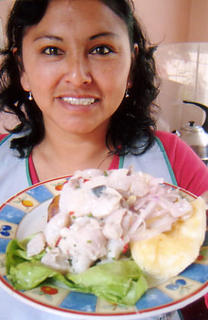Piura, Peru
 I am presently on my site visit where I will be living in the next two years. On Sept. 2 Peru Five training group will swear in as Peace Corps Volunteers and move throughout Peru to start service. The current sites are the coastal sites of Trujillo, Chiclayo, Piura, and Lima. Other spots include the Andean regions in Ancash, Cajamarca and upper Piura. Some people will live in large cities and some in tiny Quechuan and Spanish speaking communities. I think everyone will have completely different experiences since Peru is so rich with different cultures. Some volunteers have horses and donkeys as transportation and some will ride surf boards. Volunteers have told us that everyone will be dealt good cards and bad cards so be flexible and be happy with what you have. Regardless, I believe the bad cards are just a state of mind that can be molded with patience and understanding.
I am presently on my site visit where I will be living in the next two years. On Sept. 2 Peru Five training group will swear in as Peace Corps Volunteers and move throughout Peru to start service. The current sites are the coastal sites of Trujillo, Chiclayo, Piura, and Lima. Other spots include the Andean regions in Ancash, Cajamarca and upper Piura. Some people will live in large cities and some in tiny Quechuan and Spanish speaking communities. I think everyone will have completely different experiences since Peru is so rich with different cultures. Some volunteers have horses and donkeys as transportation and some will ride surf boards. Volunteers have told us that everyone will be dealt good cards and bad cards so be flexible and be happy with what you have. Regardless, I believe the bad cards are just a state of mind that can be molded with patience and understanding.In reality, it is the people that we learn from and befriend that make any site what it is. If you are in a beautiful site in the Andes or on the beach, if the community doesn't respect or like you you will have a long two years. Likewise, if you are working in a land fill with severely impoverished people that share love and respect with you, you might have the time of your life working in a land fill. It is all a state of mind.
Currently Peace Corps Peru has no sites in the jungle. My site will be in the department capital of Piura, a coastal city with roughly 350,000 inhabitants. Piura is about an hour from the coast and 1.5-3 hours to some of the most beautiful beaches in Peru. Piura lies in the desert which explains why we have so much sun and heat in the summer time. There are a couple of months in the summer (Dec-Mar) where we have plenty of rain. Piura has a much more liberal culture than other regions in Peru. For instance Cajamarca and Ancash are very much more conservative in thier actions and dress than many coastal cities. It is common to see people wearing shorts here in Piura while in Cajamarca you would see much more vibrant traditional dress and women wearing tall hats. Piura is also known to be near some of the best surf spots in South America and depending on the time of year, some of the best waves in the world. With that in mind, I imagine in the next two years you might find an Okie like myself learning how to ride a surf board. I will update more about Piura when I move here. Ciao....



